TRAVELING DRAGON SWORD AND ITS APPLICATION
OVERVIEW
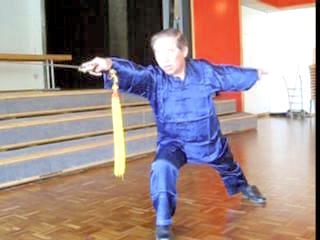
The Traveling Dragon Sword
The Traveling Dragon Sword is the favorite weapon of Grandmaster Wong. The video series shows the Traveling Dragon Sword in Switzerland on 27th, 28th and 31st August 2009, highlighting some special features in using the Traveling Dragon Sword and its combat applications.
How to Execute the Signature Sword Technique Correctly

It is imnportant to handle a sword correctly, including holding the sword-finger, and to execute the signature sword technique, the sword thrust, paying attention to waist rotation and channeling spiral force to the tip of the sword. This pattern is called "Green Dragon Shoots Pearl".
Click Traveling Dragon Sword to enter.
Dont Use s Sword like a Sabre
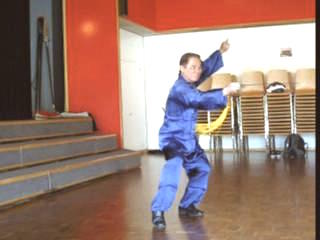
A common mistake many students make is to use a sword like a saber. A saber is forceful and is often swung round the exponent's body. A sword is gentle and is never swung round the exponent's body. The movements of a saber come mostly from the shoulder, whereas those of a sword come from the wrist. A sabre is like a ferocous tiger; a sword is like a graceful dragon.
Click Traveling Dragon Sword to enter.
Learning the Traveling Dragon Sword Set - Sequences 1 to 5

The dainty Chinese sword is often described as a dancing phoenic, but the Shaolin sword, while graceful, is more forceful, and is described as a traveling dragon. Its performance, therefore, should resemble a majestic dragon traveling through the clouds in heaven.
Click Traveling Dragon Sword to enter.
Learning the Traveling Dragon Sword Set - Sequences 5 to 8

Agility and wrist-work are very important in using a Chinese sword. The tassel at the tip of the sword-handle is meant to help students train good wrist-work. If the wrist-work is faulty, the tassel will be entangled in the wrist.
Click Traveling Dragon Sword to enter.
Learning the Traveling Dragon Sword Set - Sequences 9 to 12
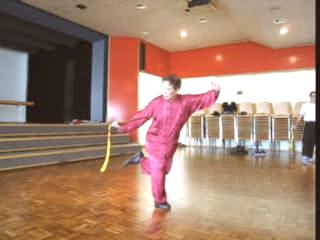
Sword movements are very beautiful to watch. Some people may wonder whether these beautiful movements can be used for fighting. Of course, they are as combat effective as they are beautiful. Subsequent video clips will show some of their remarkable combat applications.
Click Traveling Dragon Sword to enter.
Two Approaches in Learning Combat Application
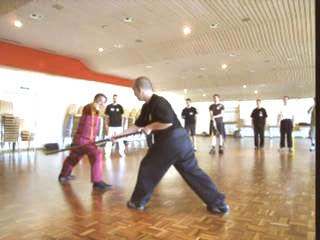
There are two main approaches in learning combat application in both unarmed and armed combat, namely situation-pattern approach and pattern-situation approach. In the situation-pattern approach we examine various combat situations and find out suitable patterns from our sword set to handle these situations. In the pattern-situation approach we find out how the various patterns in our sword set can be used in combat. There are some important ways how a sword should and should not be used in combat.
Click Traveling Dragon Sword to enter.
Working out Applications to Meet Combat Situations

Course participants worked on their own to find out how to apply the sword to handle various combat situations. This was the situation-pattern approach. The course participants not ony gained much insight into sword application, they also had a lot of fun.
Click Traveling Dragon Sword to enter.
The Importance of Avoiding the Opponent's Strength
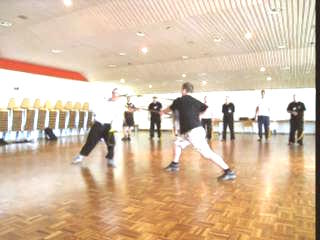
Sifu Ronny and Sifu Roland worked out some effective ways in applying a sword against a staff. An important principle is to avoid the opponent's strength. Applying this principle they worked out many effective techniques to counter attacks from a staff.
Click Traveling Dragon Sword to enter.
Against a Guan Dao and a Samurai Sword
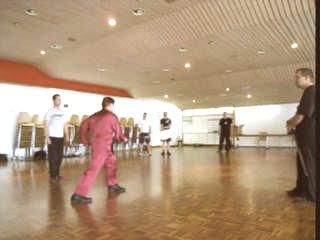
The Chinese sword is a dainty weapon. How would you use this dainty weapon against a long, heavy weapon like a Guan Dao, or a ferocious weapon like a Samurai sword? Course participants had a lot of fun working out counters against attacks from these weapons. They also discovered some important principles.
Click Traveling Dragon Sword to enter.
Agile Footwork and Picture-Perfect Form
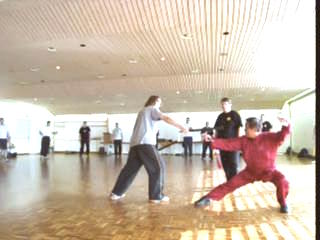
When working out counters to handle various combat situations, course participants discovered some important principles of good swordsmanship. One important principle is to flow with the opponent's momentum. To achieve this, it is necessary to have agile footwork and picture-perfect form.
Click Traveling Dragon Sword to enter.
Flowing with the Opponent's Momentum
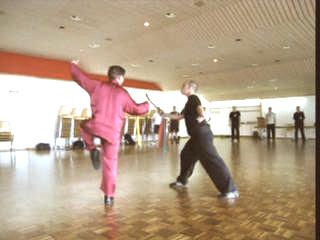
Unlike with a saber which you may use to block or deflect, you do not clash your dainty sword with an opponent's weapon. Hence, it is of utmost importance that you have agile footwork and correct spacing to avoid the opponent's attacks. Never, for example, go directly into the momentum of your opponent.
Click Traveling Dragon Sword to enter.
From Pattern to Situation in Combat Application
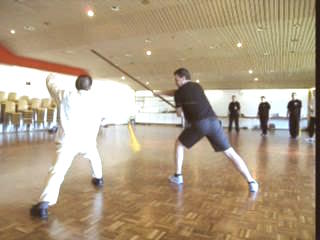
"From situation to pattern", shown in Parts 6 to 11 of this video series of the Traveling Dragon Sword, is one of the two main approaches in learning combat application. The other approach is "from pattern to situation", shown in Parts 12 to 22. After explaining some fundamental principles and demonstrating some examples, course participants worked out the combat application of some patterns they selected. It was heartening that they came out with good results. A few demonstrated some excellent applications.
Click Traveling Dragon Sword to enter.
Correct Spacing is of Utmost Importance
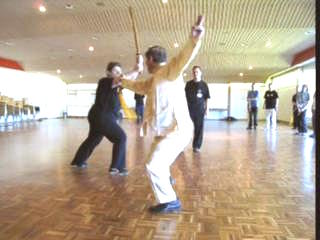
Unlike a saber which can be used to block an opponent's weapon, a sword is too dainty for this purpose. Right spacing, so that you are safely away from the opponent's weapon, is therefore of utmost importance. Notice the huge difference spacing can make in the situations shown in the videos although both the attacking and the countering techniques remain the same.
Click Traveling Dragon Sword to enter.
The Deadly and the Merciful Aspects of Swordsmanship
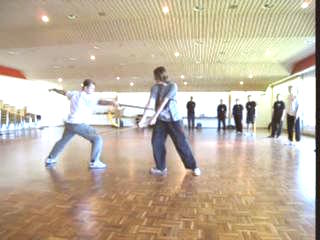
The sword can be deadly or merciful, depending on the intention of the swordsman. Both these aspects are shown in the combat applications worked out by the course participants themselves. Patterns like "Green Dragon Shoots Pearl" and "Golden Dragon Shoots Tongue" can kill an opponent in one move, whereas "Phoenix Dots Head" and "Point at Stars Look at Moon" merely disarm or disable an opponent from combat. But of course the final decision to be deadly or merciful lies with the swordsman, not the techniques.
Click Traveling Dragon Sword to enter.
Sword Patterns are as Combat Effective as they are Beautiful and Poetic
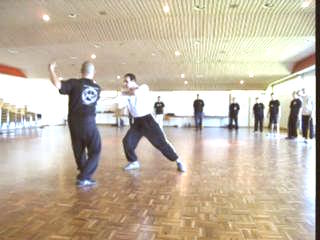
Sword patterns are not only beautiful to watch, their names are also very poetic, like "Separate Mist to Find Silence", "Point at Stars Look at Moon", and "Dry Mist on Lotus Platform". It is a big mistake to think that they are only decorative and poetic; they are very effective in combat. Of course, the sword exponent must not only know their combat application but also has the skills to use them. Sadly, most students who practice with a sword today only perform its beautiful forms.
Click Traveling Dragon Sword to enter.
Subtleties of the Sword and the Spear
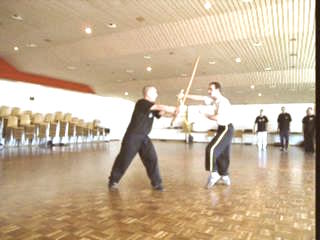
The sword is a very subtle weapon, capable of many intricate techniques that opponents may not even think possible. Sifu Ronny Singer, for example, used the pattern "Traveling Dragon Rolls Clouds" to disarm an opponent with a Samurai sword, giving him no chance to escape. But, of course, the swordsman must also be careful of the subtleties of other weapons. Some subtle movements of the spear were shown.
Click Traveling Dragon Sword to enter.
Kungfu, Armed or Unarmed, is Alive
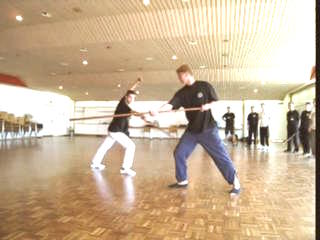
Kungfu, armed or unarmed, is alive; we should not limit ourselves to rigidity. If a pattern is performed in a Single-Leg Stance in a set, for example, it does not mean that we must always use it in that stance. If the situation warrants it, we may perform the same pattern in a different stance, as in the pattern "Night Guard Tests Sea" performed here in a Bow-Arrow Stance whereas it appears in the Sword set in a Single-Leg Stance.
Click Traveling Dragon Sword to enter.
Great Skills and Techniques are Needed in Using a Sword
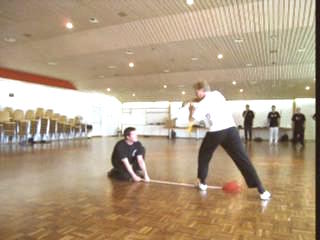
If you are big and strong and defeat a small-sized opponent, it is due to your physical strength and is nothing spectacular. But if you are small-sized, and you defeat a big, strong opponent, it is due to your skillful use of sophisticated techniques. Similarly, if you use a dainty weapon like a sword, you need great skills and techniques to defeat opponents using long, heavy weapons. Here, course participants used the sword to defeat opponents using a Samurai sword, a staff and a Guan Dao which were physically stronger.
Click Traveling Dragon Sword to enter.
Against Heavier as well as Lighter Weapons
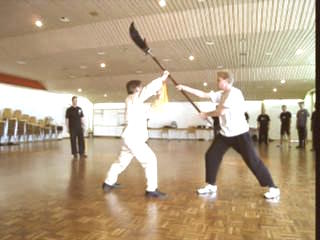
A Chinese sword (jian) is different from a saber (dao). Indeed a tell-tale sign that a person does not know how to use a sword is when he uses it like a saber, like using it to block a heavy weapon. On the other hand, how would you use a sword against an even lighter and faster weapon like a rapier?
Click Traveling Dragon Sword to enter.
The Sword was the Choice-Weapon of Kungfu-Knights
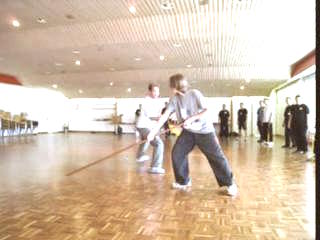
The sword was the choice-weapon of kungfu-knights (jian-xia or free-lance kungfu experts who were chivalrous and often wholesomely amorous) in the past. Instead of killing or maiming their opponents, the kungfu-knights usually just disarmed them or demonstrated their superior swordsmanship over them, like tearing their clothing with the tip of the sword. These video clips provide you with some techniques to be kungfu-knights. Of course you also need the necessary skills.
Click Traveling Dragon Sword to enter.
Combat Applications of Some Sophisticated Patterns

Some of the sword patterns are so sophisticated that their combat applications are not obvious, and they look like decorative patterns merely for show. Some examples are "Dark Phoenix Spreads Wings", "Carry Moon in Bosom" and "Green Dragon Washes Claws". Course participants worked out the combat applications of these sophisticated patterns. You may be surprised at some of the results.
Click Traveling Dragon Sword to enter.
They are as Beautiful to Watch as they are Combat Effective
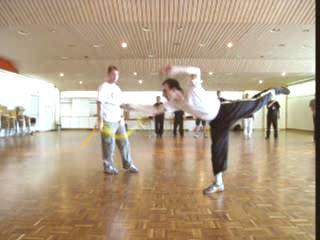
Do you know how these patterns are used in combat: "Green Dragon Plays with Water", "Traveling Dragon Rolls Clouds", "Dragonfly Dots Water", and "Reverse Hanging of Purple Bell"? They are as beautiful to watch as they are combat effective. Before the course, most of the course participants had no idea of their combat functions. But towards the end of the course, they came out with very sophisticated applications. This training also enabled them to understand combat applications of patterns they saw for the first time.
Click Traveling Dragon Sword to enter.
LINKS
Traveling Dragon Sword and its Application
- How to Execute the Signature Sword Technique Correctly
- Don't Use a Sword as a Sabre
- Learning the Traveling Dragon Sword Set - Sequences 1 to 5
- Learning the Traveling Dragon Sword Set - Sequences 5 to 8
- Learning the Traveling Dragon Sword Set - Sequences 9 to 12
- Two Approaches in Learning Combat Application
- Working out Applications to Meet Combat Situations
- The Importance of Avoiding the Opponent' Strength
- Against a Guan Dao and a Samurai Sword
- Agile Footwork and Picture-Perfect Form
- Flowing with the Opponent's Momentum
- From Pattern to Situation in Combat Application
- Correct Spacing is of Utmost Importance
- The Deadly and the Merciful Aspects of Swordsmanship
- Sword Patterns are as Combat Effective as they are Beautiful and Poetic
- Subtleties of the Sword and the Spear
- Kungfu, Armed or Unarmed, is Alive
- Great Skills and Techniques are Needed in Using a Sword
- Against Heavier as well as Lighter Weapons
- The Sword was the Choice-Weapon of Kungfu-Knights
- Combat Applications of Some Sophisticated Patterns
- They are as Beautiful to Watch as they are Combat Effective
